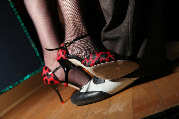
HOME
TANGO CORNER
ART/CULTURE
TRAVEL
NEWS/EVENTS
“A SENSORY BRIDGE TO GLOBAL CULTURE”


Advertise in:

AS WE INAUGURATE
TANGO LIFE & NEWS
TAKE ADVANTAGE OF OUR EXCLUSIVE
ONE-TIME OFFER TO PLACE YOUR AD HERE
FREE DURING NOVEMBER!
ADVERTISERS, DON’T MISS THIS CHANCE TO FEATURE
YOUR BUSINESS IN PREMIUM WEB SPACE
THAT WILL BE SEEN BY A GLOBAL AUDIENCE!
FOR DETAILS.
312.287.8406
AS A SPECIAL INTRODUCTORY BONUS, YOU’LL ALSO RECEIVE A DISCOUNT ON ADS PLACED THROUGH JANUARY 6, 2011.
In ballroom dancing, rules govern navigation and traffic, line of dance, etc. But crowded tango floors present a different kind of challenge, and most of this falls upon the man. In both styles, the man must acquire three basic skills — to learn how to dance, of course, then to lead. A whole other skill of equal importance is to navigate a crowded floor.
 The man is charged with the responsibility to lead the woman in his embrace in a
comfortable and safe way around the floor. In ballroom, this is reflected in the
expression, “The man is the frame, and the lady is the picture.” Similarly, the man’s
role in tango is to showcase and protect the woman. The leader must be aware of the
motion of other dancers, conditions of the dance floor, and the particular music
being played.
The man is charged with the responsibility to lead the woman in his embrace in a
comfortable and safe way around the floor. In ballroom, this is reflected in the
expression, “The man is the frame, and the lady is the picture.” Similarly, the man’s
role in tango is to showcase and protect the woman. The leader must be aware of the
motion of other dancers, conditions of the dance floor, and the particular music
being played.
Good navigation means he must have complete control of the follower's movements —
ready to react to sudden interruptions to line of dance flow both in front and behind
him. He must be ready to handle unexpected changes of direction, dictated by the presence of obstacles or the actions of other dancers. When the dance floor really
gets crowded, skillful navigation is priceless because it enables great dancing in
short circular trajectories while simultaneously improvising all kinds of patterns
in heavy traffic — without banging your partner against objects or other dancers
around you.
presence of obstacles or the actions of other dancers. When the dance floor really
gets crowded, skillful navigation is priceless because it enables great dancing in
short circular trajectories while simultaneously improvising all kinds of patterns
in heavy traffic — without banging your partner against objects or other dancers
around you.
Navigating on a crowded dance floor is called "floorcraft" and is an essential skill for every leader. The follower trusts him to keep her safe from collisions, or being trodden upon or kicked by bulky men’s shoes or razor sharp stilettos. At all cost, the “frame” must remain vigilant of potential harm to his “picture.”
The first concept of floorcraft is the "line of dance" (LOD), or a lane of dancers moving counter-clockwise around the outside of the dance floor, some at top speed. The inner lane’s for somewhat slower or conservative dancers, and the center lane is for those wanting to show off decorative moves, slow patterns or just drift romantically.
Just like traffic on a busy road, the LOD can move quite smoothly if no one passes,
and each car follows the one in front. However, it only takes one car to suddenly
stop or ![]() change lanes to disrupt the whole flow. LOD violations typically cause milongueros
(gentlemen tango dancers) to gently mutter under their breaths, while their somewhat
more animated ballroom counterparts may yell, “LOD! LOD!” to offending “drivers.”
change lanes to disrupt the whole flow. LOD violations typically cause milongueros
(gentlemen tango dancers) to gently mutter under their breaths, while their somewhat
more animated ballroom counterparts may yell, “LOD! LOD!” to offending “drivers.”
Dancing on a crowded floor where there’s good floorcraft is a pleasure in itself. A sense of unity with the other dancers can leave one feeling elated by the ambiance. Of course, this skill takes practice and time to learn.
Tango etiquette also demands that a couple, not just the leader, be cognizant of available space and movements of nearby dancers. It’s not OK for the woman to be oblivious. Rather, she is also responsible for containing leg movements when there’s little or no open space. Flamboyant embellishments are saved for empty corners or, as some think, show tango.
ETIQUETTE ON AND OFF THE DANCE FLOOR
“CHARM SCHOOL” PRIMER FOR DANCERS
Though it’s quite customary for tango followers to dance with eyes closed, entranced by the lead, it’s more sensible, respectful and polite for the woman to keep an eye out for potential hazards not always discernable by the man. The ballroom rule, “whoever goes forward is leading,” has merit. There are times when the follower can safeguard her man (leader) by warning of traffic in his blind spots. Likewise, both leader and follower are well advised to be aware of flying boleos, ganchos (dramatic legwork) and such — after all, tango is the “war of the legs!”
To help those new to social tango, and to remind those of us who are more experienced, the following guidelines are helpful to observe on a crowded floor.
“Charm School Primer” For Tango Dancers
1. Leaders need to move down line of dance (LOD), that is, counter-clockwise around the dance floor in an outer lane.
2. No passing ― if someone in front of you is slow, then dance your partner in neat circles until space opens up.
3. If you notice that there’s a gap in front and a queue behind you, then move along to even out the spacing.
4. Stay in the lane ― don’t move outside into the center and then back again.
5. Allow the person in front of you enough space to take one step backwards.
6. Do not take more than one step backwards against the LOD.
7. If you enter the dance floor after the music starts, wait patiently until a gap opens up to lead your partner onto the dance floor.
8. Restrict the moves you lead to be contained within a circle that you could draw with one of your feet.
9. Keep your follower's feet on the ground.
10. Ladies, restrict your movements to those led. It is your leader's responsibility
to ensure that there’s enough space to perform
a particular move. It’s difficult for
you to see if it is safe to stretch your leg out, or kick, and unintentional injuries
can result.
11. If you want to lead moves that require space or require that you be stationery for more than a few beats, then move to the middle of the floor.
12. The outside lane has right of way. If you’re in the middle, ensure that there’s enough space between you and the LOD. Also, note that some floors are just too small and do not really have a middle.
13. The leader has to choose which moves are appropriate to the music and the particular dance floor. Certain moves are just not possible unless there is space. Resisting the urge to perform your latest move helps create a great tango experience for everyone. This applies even if you are excited and have just learned it in the pre-milonga lesson.
14. On the positive side, dancing on a crowded floor can be a pleasure in itself. Take the time to acquire the skill, and keep a positive attitude if a more experienced dancer tries to pass along some advice. Ultimately we all want to have an enjoyable experience together and above all, to keep the women safe.
15. By all means, as the floor opens up at the end of the evening, bring out the latest showy moves. The DJ often structures the type of music played to enable this.
Milonga etiquette
A milonga, or tango social dance, has a its own set of rules that differ from ballroom. The most obvious of these involve how to accept and show appreciation for a dance. This is one area where the experienced ballroom dancer can easily make an innocent faux pas. In ballroom, a dancer will accept an offer and eagerly say “thank you” at the end of each dance. This is kiss of death in tango etiquette, where a “thank you” said prematurely (for instance, after only one dance) borders on insult to the partner.
A group of three or four of the same kind of dance ― tango, milonga or vals ― is played consecutively in what’s known as a “tanda.” The tanda is distinguished by contrasting, non-danceable musical interlude to signify the end of one and beginning of another. When a couple agrees to dance, they are coupling up for the entire tanda or set, and expected to complete it. To say “thank you” or stop dancing with that partner before the entire tanda’s over indicates one’s rudeness or displeasure with that partner. Such behavior’s usually reserved for unavoidable situations like feeling sick or injured, or need to go to the bathroom for instance. Any other reason would be a show of ill manners.
If either the lady or man finishes a tanda early or declines one altogether, it’s understood that he/she would not dance with another person during that same tanda. To do so would insult the snubbed dancer and cause him/her to refuse to dance with that person in the future.
The way one partner encounters another is also different than what’s found in other dance worlds. Rather than ask directly, a man will initiate the cabaceo ― or suggestive eye contact ― to invite a woman to dance. Today, it’s also acceptable for a woman to initiate cabaceo, although still not considered totally proper in all tango circles. A nod is all that’s needed for the partners to approach the floor. If someone doesn’t wish to dance with a particular person, the correct etiquette would be to deliberately avoid eye contact, and in the process, rejection. A downward glance politely conveys the message.
Since a tanda consists of the same type of dance, those who can’t or won’t dance that style would typically sit out the entire set rather than attempt any one song. For instance, many men either don’t know or don’t like to dance milonga (the dance style), so they’d just wait for the next tanda.
“Like tango, like life.”
You may have heard of the expression "Like tango, like life," meaning that tango is a reflection of life, and life a mirror of tango. If we apply the same principles we do in life to our tango dancing and vice versa, good manners will enable us to enjoy each other's company, and to receive the respect we in turn give others, both on and off the dance floor.

Photo above courtesy of Proyecto Tango© 2010
